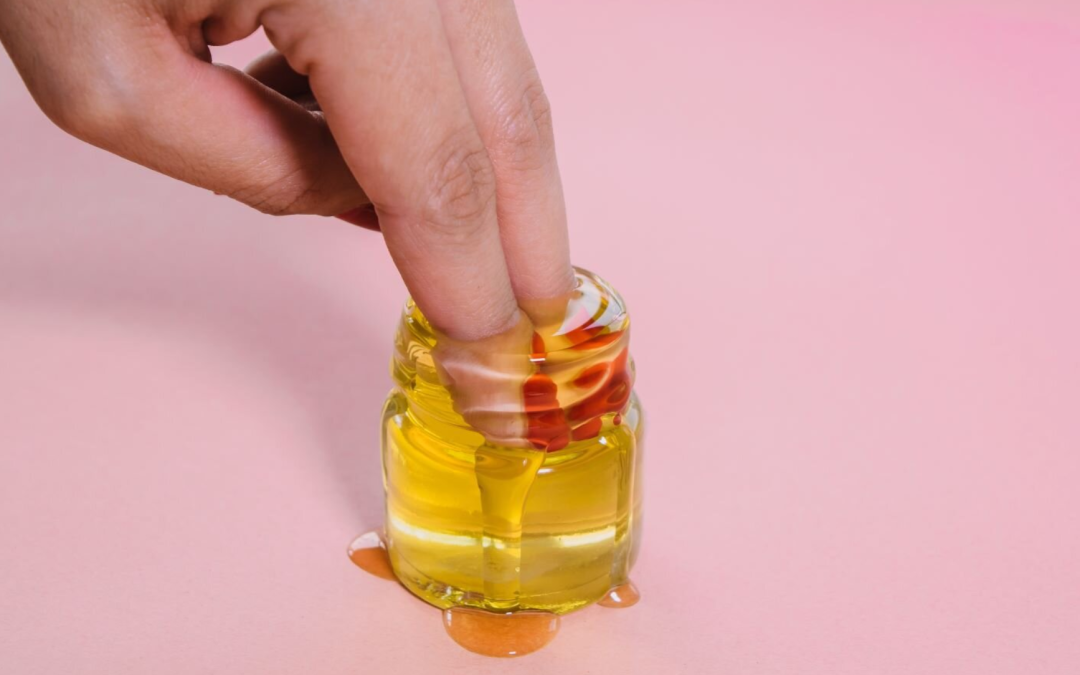Why is an Oil Serum better than a cream?
Moisturizing is essential to diminish the appearance of wrinkles and to achieve supple, smooth and soft skin.
The most superficial layer of the skin, the stratum corneum, has a water content between 10 and 20%. Water levels below 10% make the skin more fragile, rough and less shiny. Between 600 and 1200 ml of water is lost daily through the skin.
One of the mechanisms to moisturize the skin are emollients, such as vegetable oils. These are the most important component after water in creams.
They act by creating a protective (but not occlusive) film that prevents transepidermal water from evaporating. They also replenish the skin’s fatty acids that are being lost. They soften, lubricate and protect the skin from external irritants and pathogens.
What is my experience?
After having tried a few dozen of them and leaving my face looking like a salad, my 2 absolute favorites that I would choose to create an oil serum are
Jojoba oil (Simmondsia chinensis seed oil )
Meadowfoam oil : ( Limnanthes Alba seed oil )
Why do I love them ?
As soon as I put them on, they leave my face more luminous, juicy, comfortable and with a super soft texture. If I apply them in the evening, my skin looks smooth and relaxed in the morning and protects me from dehydration after showering.
Their composition is very similar to the skin’s natural sebum, they regulate sebum production and have a high compatibility and tolerance in all skin types, including oily skin.
- Dry touch : penetrates quickly into the skin leaving a non-oily feel, and the skin is matte, without shine.
- Very stable, they maintain their properties for years (do not oxidize, do not become rancid).
- Toilets
There are many others that I love but for those who are not used to this texture may be a little less comfortable.
Olive oil and its derivatives (super moisturizing and nourishing), sunflower oil (ideal as a cleanser and make-up remover), avocado oil (super moisturizing) and camellia oil (anti-aging).
Multiple forms of use: Invent yours
It should be noted that a cream is mainly water, generally water-soluble active ingredients and oils or emollients.
Using a good serum loaded with powerful active ingredients and then applying an oil to fix, protect and moisturize is what is giving me the best results.
These are the forms that I use, although I’m sure you can find others that suit you !
- Simply apply to clean dry or slightly damp skin when you are feeling very minimalist or want to give yourself a rewarding self-massage.
-
- add a few drops of my favorite essential oils at night (lavender or geranium for example).
- Before doing sports, with the heat of exercise, it helps to better dissolve accumulated dirt on the skin.
- On the hair, massage the ends to moisturize and prevent frizz.
- On the body with wet skin after showering or before going to sleep.
- Before doing sports, with the heat of exercise, it helps to better dissolve accumulated dirt on the skin.
- On the hair, massage the ends to moisturize and prevent frizz.
- On the body with wet skin after showering or before going to sleep.
If you want to know more ……
Vegetable oils are compatible with the lipid layer of the skin, they penetrate the skin and allow its oxygenation.
Vitamin E, naturally present in vegetable oils, helps photoprotection (neutralizes free radicals) and re-epithelialization of the stratum corneum.
A proper moisturizing treatment must repair the skin’s lipid barrier, restoring its ability to attract, retain and redistribute water. Ideally, a moisturizing product should not only be effective in terms of preventing water loss, but also be a good emollient, soothe and soften the skin, be respectful of sensitive skin, hypoallergenic, fragrance-free, and non-comedogenic.
Oils (which can be natural or synthetic, of vegetable, animal or petroleum origin) are the most important component after water in creams (emulsions), which is why they are usually at the top of the list of ingredients of a cosmetic.
All vegetable oils contain: triglycerides, fatty acids, tocopherols (vitamin E), retinol (vitamin A) and other fat-soluble vitamins, phospholipids, sterols, squalene and phenolic compounds (antioxidants). Their ratio will give the final cosmetic properties and their potential benefits.
There is a great variety of more or less exotic vegetable oils depending on their geographical or vegetable origin and where they are extracted from (fruits, seeds or flowers).
Bibliography
Vegetable Oils in Cosmetics (Dr V. Donat, Cosmetic Industry 002 )

